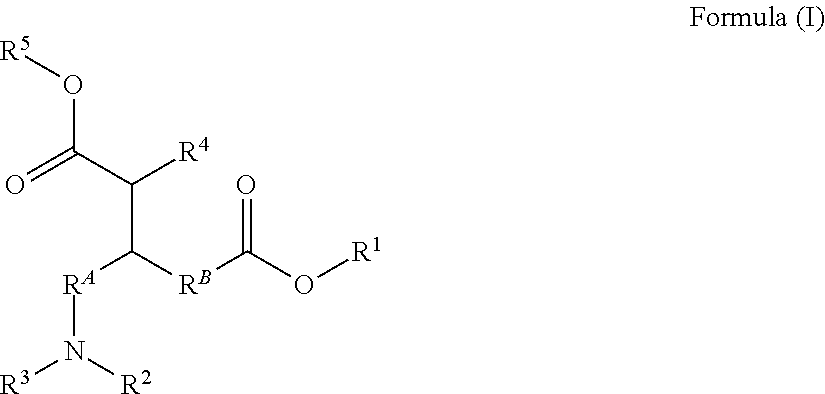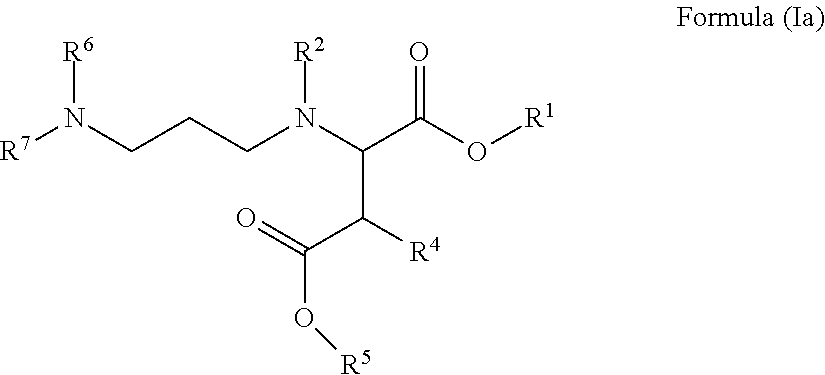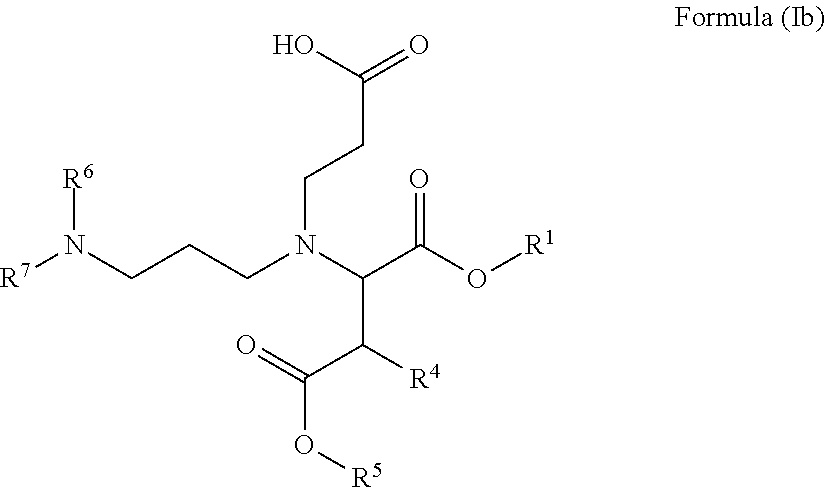Carboxy alkyl-ester Anti-agglomerants for the control of natural gas hydrates
a technology of carboxy alkyl esters and anti-agglomerants, which is applied in the preparation of asymmetrical anhydrides, gaseous fuels, fuels, etc., can solve the problems of loss of oil or gas production, safety hazards for field workers, damage to transmission lines and equipmen
- Summary
- Abstract
- Description
- Claims
- Application Information
AI Technical Summary
Benefits of technology
Problems solved by technology
Method used
Image
Examples
example 1
of Maleic Anhydride-Alcohol, 2-Ethyl Hexanol, and Pyrrolidine
[0174]Maleic anhydride (5.00 g) and 2-ethyl hexanol (6.64 g) were added to a vial with a stir bar. At ambient temperature, the maleic anhydride in the solution of 2-ethyl hexanol was solid. The mixture was heated to 60° C. with stirring and left at 60° C. overnight. After stirring overnight at 60° C., the solution was free-flowing and homogenous with dispersed solid particles. Thin layer chromatography (TLC) showed that 2-ethyl hexanol was consumed in the reaction.
[0175]The vial was heated to 80° C. and the solid particulate dissolved. After stirring for approximately eight hours at 80° C., approximately 4.5 mL of pyrrolidine (4.26 g) was added. A sub-stoichiometric amount of pyrrolidine was added so that the reaction could be better monitored. The reaction was then cooled to ambient temperature and solidified. Generally, the reaction proceeded as depicted in Scheme 1.
[0176]Two TLC plates were processed with separate solve...
example 2
of Maleic Anhydride and Various Alcohols and Amines
[0178]The reagents used in this Example and corresponding amounts of each are listed in Table 1.
TABLE 1Reagents for Reaction of Maleic Anhydride with Various Alcohols and AminesAmount MaleicAmountAmountAnhydride Alcohol Amine Reaction(g)Alcohol(mL)Amine(mL)10.881-hexanol1.12Pyrrolidine0.7420.881-hexanol1.12Dibutylamine1.5132.00ALFOL 8103.56Pyrrolidine1.6742.00ALFOL 8103.56Dibutylamine3.4452.00ALFOL 103.88Pyrrolidine1.6762.00ALFOL 103.88Dibutylamine3.4472.00ALFOL 12144.85Pyrrolidine1.6782.00ALFOL 12144.85Dibutylamine3.44
[0179]Generally, the procedure for each reaction was as follows. The alcohol and maleic anhydride were added to a 20-mL vial with cross-shaped stir bar at ambient temperature. The mixture was stirred at 250 rpm and heated to 80° C. The maleic anhydride dissolved upon heating.
[0180]At reaction start time, a significant amount of maleic anhydride was present in the mixture, as determined by TLC. At one hour, some maleic...
example 3
of Maleic Anhydride, 2-Ethyl Hexanol, Isopropanol, and Pyrrolidine
[0183]Maleic anhydride (3.28 g) and 2-ethyl hexanol (4.35 g) were added to a 40-mL vial with a cross-shaped stir bar. The mixture was stirred at 250 rpm and heated to 60° C. for three hours. The reaction was then cooled to 30° C. and isopropanol (10.00 g) was added. The stir rate was increased to 500 rpm and pyrrolidine (2.38 g) was added slowly. The reaction was then heated to 60° C. to provide the final product
PUM
| Property | Measurement | Unit |
|---|---|---|
| Fraction | aaaaa | aaaaa |
| Fraction | aaaaa | aaaaa |
| Volume | aaaaa | aaaaa |
Abstract
Description
Claims
Application Information
 Login to View More
Login to View More - R&D
- Intellectual Property
- Life Sciences
- Materials
- Tech Scout
- Unparalleled Data Quality
- Higher Quality Content
- 60% Fewer Hallucinations
Browse by: Latest US Patents, China's latest patents, Technical Efficacy Thesaurus, Application Domain, Technology Topic, Popular Technical Reports.
© 2025 PatSnap. All rights reserved.Legal|Privacy policy|Modern Slavery Act Transparency Statement|Sitemap|About US| Contact US: help@patsnap.com



